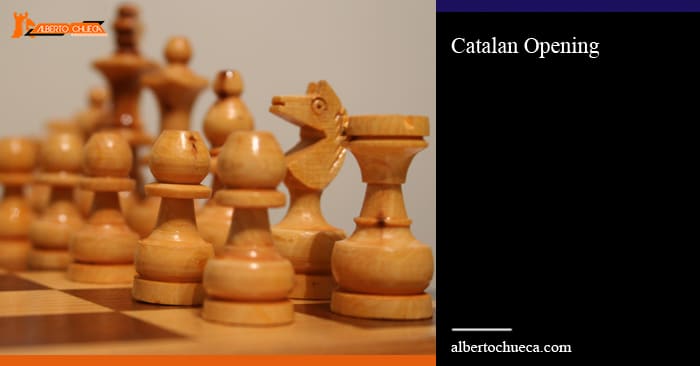Table of Contents
Catalan Opening
Today we are going to study a very famous and strong variation for White: Catalan Opening. The Best Masters in the World still play it very often, so, definitely, it is a pretty good opening, and at the same time it is an easy and interesting option for players wanting to improve. We are going to analyze and understand some theory, general plans and typical development squares for white pieces.
Great Masters who played Catalan Opening
Great Chess legends like Garry Kasparov, Viktor Korchnoi, Vladimir Kramnik, and Viswanathan Anand played Catalan Opening in their Chess Careers, in general with good results.
Some theory and ideas in Catalan Opening
We have Catalan Opening after the moves
1.d4 d5 2.c4 e6 3.g3
(This is probably the most regular order, but there are many transpositions still getting into Catalan Opening)
Basically White wants to play d4, c4, Nf3, g3, and Bg2. There is a very interesting connection between the move c4 and the development of the light squares Bishop over the Fianchetto since the “c” pawn is undermining the black central pawn on d5, which means the great diagonal could be open and the Catalan Bishop (White’s light squares Bishop on g2) will be a very important weapon in these variations.
3… Nf6 4.Nf3
In general Black will have two different ways to face Catalan Opening: they can either accept the gambit on c4 at some point, which is called Open Catalan, or, they can just continue a normal development, not taking on c4, and this is what they call Closed Catalan.
Open Catalan
In this variation, Black has two different approaches: they can just give back the extra pawn and try to continue improving his position as soon as possible, or they can just protect the extra pawn, the problem with this option is that the second player will have to weaken the Queenside to defend the pawn on c4 with moves like a6 or b5. Let’s see the mainline:
4… dxc4
When Black accepts the Gambit, the Bishop on g2 is turning into a great piece. This is one of the greatest compensations for White in this line. Besides, this Bishop is going to be connected to the Kingside Knight going to e5 and to the Rook, over the “a” or “c” file, putting some pressure on Black’s Queenside. Also, it will not be easy for the second player to develop the light squares Bishop, since White will be attacking b7.
5.Bg2 a6 6.0-0 Nc6
7.e3 Bd7 8.Nc3 Nd5 9.Nd2
White has better control in the center and a lead in development as compensation for the pawn down.
Closed Catalan
4… Be7
Black does not accept the pawn and continues a normal development.
5.Bg2 0-0 6.0-0 c6
Black is still in time to take the pawn and to transpose to Open Catalan: 6… dxc4 7.Qc2 a6 8.Qxc4 = and here there are equal chances for both players.
7.Bf4 b6 8.Qc2 =
Objectively the game is balanced, but we need to say that in these positions it is easier to play as White.
Typical Plans in Catalan Opening
Open Catalan
White is going to try to get the pawn back, with moves like Qc2, Qa4, Ne5 or Nd2. If Black defends the pawn with the plan a6-b5, then they are weakening the Queenside. The Catalan Bishop is extremely powerful over the Great Diagonal in those positions. A very common move to undermine Black’s structure is a4! Then the Rook on a1 will put annoying pressure on the “a” file.
Black can also give back the pawn on c4 and try to improve his position as White loses some tempos recovering the pawn. Moves like c5, attacking White’s central pawn are very common. Usually Black wants to simplify the position, reduce the pressure and probably get into some endgame with opposite-colored Bishops (which are very likely to end up in a draw).
Ne5 is again a typical and important move for White. This move is not only improving the Knight but also hindering the development of Black pieces (like the Knight going to c6). If the first player can recapture on c4 and avoid the move c5, usually White will have some advantage because of the pressure on the “c” file and the pawn on c7. Then White can try to strategically control the weak square c6 with Rook on c1, plus Knight on e5 and Bishop on g2.
Closed Catalan
These positions are quieter, and White tries to improve slowly. The Knight can go to e5 (one more time). There are some ideas with a break in the center, so sometimes White can also try Nfd2, clearing the line for the Bishop, supporting the move e4, and avoiding the typical move Ne4. The middlegames are more or less balanced, but in general, it is easier to play as White, since Black pieces do not have too much space to move.
Typical squares for white pieces in Catalan Opening
King: White always castles Kingside in this line.
Queen: It goes almost always to a4 or c2, attacking or controlling c4, and also supporting the advance e4 (from c2).
Rooks: Very often the Queenside Rook goes to “c”, which is usually a half-open file. Also, sometimes it can stay on the “a” file when White wants to play a4 to target black pawn on b5. The Kingside Rook usually goes to e1 or d1.
Bishops: The light squares Bishop is the “Catalan Bishop”, it is an extremely important piece for White in this system. It is controlling the Great Diagonal and it will be essential in the compensation for the first player when Black accepts the Gambit. The dark squares Bishop usually goes to f4, attacking c7 and controlling that nice diagonal.
Knights: The Queenside Knight goes to c3 very often. The Kingside Knight can go either to f3-e5 or f3-d2.






